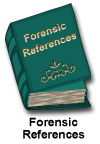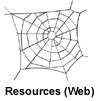|
|
 |
The
required readings for this unit are:
 Australia
Australia |
Required
Reading(s)
|
 |
Insert article here
 Canada
Canada |
Required
Reading(s)
|
 |
Insert article here
 International
International |
Required
Reading(s)
|
 |
Insert article here
 United Kingdom
United Kingdom |
Required
Reading(s)
|
 |
UK
Coid, J., Kahtan, N., Gault, S., & Jarman, B. (2000).
|
Women
admitted to secure forensic psychiatry services:
I. Comparison of women and men. Journal of Forensic
Psychiatry, 11(2), 275-295. Retrieved December
20, 2002, from Academic Search Premier: http://search.epnet.com/direct.asp?an=6396489&db=aph
- Part
I. Compares the diagnostic characteristics and criminal
records of female and male psychiatric patients
in Great Britain. Annual rate of male admissions
to the secure specialist service; Evidence of more
histories of fire-setting behavior among
women; Tendency of women to receive a primary diagnosis
of personality disorder.
|
UK
Kenney-Herbert, J. (1999). The health care of women
|
prisoners
in England and Wales: A literature review. Howard
Journal of Criminal Justice, 38(1), 54-66.
Retrieved December 31, 2002, from Academic Search
Premier database:
http://search.epnet.com/direct.asp?an=3254122&db=aph
|
 United States
United States |
Required
Reading(s)
|
 |
US
Vigilante, K. C., Flynn, M. M., Affleck, P. C., Stunkle,
J. C., |
Merriman,
N. A., Flanigan, T. P., Mitty, J. A., & Rich,
J. D. (1999). Reduction in recidivism of incarcerated
women through primary care, peer counseling, and
discharge planning. Journal of Women's Health &
Gender-Based Medicine, 8(3), 409-415. Retrieved
December 19, 2002, from Academic Search Premier
database: http://search.epnet.com/direct.asp?an=5626914&db=aph
- Note:
This article presents information on the Women's
HIV/Prison Prevention Program (WHPPP) of the Rhode
Island state prison, designed to reduce reincarceration
and HIV infection. Creation of the WHPPP in 1992;
Major outcome objectives of the program; Demographics,
risk behavior and risk perception in the WHPPP.
|
Databases
For the full text article online,
sleuth the 'University
of Calgary/ Library/ Article Indexes':
Directions:
- Select
- Indexes and abstracts with links to full text articles
- Select
- Academic Search Premier or Expanded Academic ASAP
- Select
- Connect
-
Fill in
User ID and Pin
- Fill
in search words:
female and offender
Top of Page
|
 |
 |
The
'recommended only' readings for this unit are the following:
 Australia
Australia |
Recommended
Reading(s)
|
 |
Insert article/book/chapter here
 Canada
Canada |
Recommended
Reading(s)
|
 |
| MacDonald,
M. (2001). Creating choices, changing lives: |
The
transformation of women's corrections in Canada.
Corrections Today, 63(1), 70-74. Retrieved
July 22, 2002 from ProQuest database.
- "In
1989, a task force for federally sentenced women
in Canada was assembled to make ecommendations on
how to improve the situation facing female offenders.
Its report, Creating Choices, was submitted in April
of the following year and, in September 1990, the
federal government accepted the recommendations
- to close the Prison for Women (which was Canada's
only prison for women serving sentences of more
than two years), and in its stead, build four regional
prisons, plus an Aboriginal healing lodge, based
on a community living environment" (MacDonald,
2001, p. 70).
|
 International
International |
Recommended
Reading(s)
|
 |
Insert article/book/chapter here
 United Kingdom
United Kingdom |
Recommended
Reading(s)
|
 |
| Byrt, R.,
Lomas, C., Gardinar, G., & Lewis, D. (2001). |
Working
with women in secure environments. Journal of
Psychosocial Nursing & Mental Health Services,
39(9), 42-50.Retrieved July 22, 2002 from Proquest
database.
- In this
article, developments in secure (i.e., locked) mental
health services for women in the United Kingdom
will be reviewed, with particular reference to Arnold
Lodge, a 56-bed, medium secure unit, located in
Leicester, a multicultural city in central England
(Byrt, Lomas, Gardinar, & Lewis, 2001).
|
 United States
United States |
Recommended
Reading(s)
|
 |
| DeBell,
J. (2001). The female offender: Different...not |
difficult.
Corrections Today, 63(1), 56-60. Retrieved July
22, 2002 from Proquest database.
- "Female
offenders are, at the very least, extremely challenging
to manage. It is crucial that correctional staff
develop and foster a basic understanding of the
differences between men and women" (DeBell,
2001, p. 56).
- As an
instructor for a myriad of both law enforcement
and corrections academy classes for the past nine
years, the old adage, "An inmate, is an inmate,
is an inmate" has been a staple of the recruit
curriculum. With the development of a new effective,
task-oriented curriculum titled "Working With
the Female Offender," staff within the Florida
Department of Corrections are learning to put this
myth to rest (DeBell, 2001, p. 56).
- "Female
offenders are, at the very least, extremely challenging
to manage. It is crucial that correctional staff
develop and foster a basic understanding of the
differences between men and women. A conscious effort
to remain professional at all times when dealing
with female offenders will ensure staff success.
Employees will be taught to think "outside
the box," as it relates to female offenders,
addressing the issues they bring with them upon
incarceration and concentrating on their success
in their new environment" (DeBell, 2001, p.
56).
|
Top of Page
|

|
Additional
references for this unit can be found in 'forensic
references'
of the forensic sourcebooks.
- Sleuth
'forensic reference' database for:
Top of Page
|

|
Video's
recommended for this unit are:
|
|
Resources
(Video)
|
 |
Insert video
here
Top of Page
|

|
 |
The
required websites to sleuth for this unit are the following:
 Australia
Australia |
Resources
(Web)
|
 |
Insert website here
 Canada
Canada |
Resources
(Web)
|
 |
| Dell, C.A.
& Boe, R. (1998). Adult Female Offenders in |
Canada.
Recent Trends Research Branch Correctional Service
Canada (May 15, 1998). http://www.csc-scc.gc.ca/text/rsrch/briefs/b21/b21e.shtml
- Note
a mean age of 32 for women involved with crime has
remained the same from 1994/95 to 1996/97.
|
| Canadian
Association of Elizabeth Fry Societies (1995). |
Women's
groups welcome review announcement. Canadian Association
of Elizabeth Fry Societies. Retrieved July 1, 2002,
from CAEFS Website: http://www.web.net/~kpate/bwdnr.htm
- Note
this report on review the cases of women imprisoned
for defending themselves against abusive partners.
|
| Pate, K.
(1994, November). Battered Women's Defence |
Committee
Update. Canadian Association of Elizabeth Fry Societies.
Retrieved July 1, 2002, from CAEFS Website: http://www.web.net/~kpate/bwdcom.htm
- Note
the project CAEFS has been involved with since 1990
when the Supreme Courts of Canada ruled in favor
on the battered woman's defence in the Lavallee
case
|
 International
International |
Resources
(Web)
|
 |
 United Kingdom
United Kingdom |
Resources
(Web)
|
 |
Insert website here
 United States
United States
|
Resources
(Web)
|
 |
Top of Page
|
 |
For
additional websites on this unit, sleuth 'forensic
websites' in the forensic sourcebooks.
Top of Page
|
 |
|